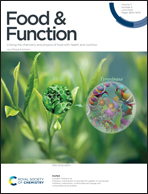Physicochemical and antibacterial properties of fabricated ovalbumin–carvacrol gel nanoparticles
Abstract
The applications of carvacrol are limited due to its poor stability and water solubility, and high volatility; however, ovalbumin can be used to encapsulate hydrophobic molecules, improve their aqueous solubility, and reduce their volatility. In this study, we fabricated ovalbumin–carvacrol nanoparticles (OCGns) under different pH (2, 5, 7, and 9) conditions using a gel embedding method and investigated their physicochemical and antibacterial properties. Rheological experiments revealed that the G′ of ovalbumin gels (OGs) prepared under different pH conditions were OG-2 > OG-7 > OG-9 > OG-5. Carvacrol addition reduced the tight structure of ovalbumin and carvacrol under pH 5 and 7 conditions, with hardness first decreasing and then increasing, but increasing under pH 2 and 9 conditions. Fluorescence and infrared spectroscopy indicated complex formation, with carvacrol increasing the average diameter of nanoparticles prepared at pH 2, 5, 7, and 9. Encapsulation reached 89.34 and 91.86% at pH 2 and 9, respectively; however, inhibition experiments revealed that the minimum inhibitory concentration of OCGn-2 against Gram-positive Bacillus cereus and Salmonella (0.08 and 0.16 mg mL−1, respectively) was lower than that of OCGn-9 (both 0.28 mg mL−1). Moreover, OCGn-2 possessed a better dense gel structure and a higher stability, encapsulation rate, and antibacterial activity, suggesting that pH affects gel microstructure and thus the encapsulation efficiency and bacteriostatic properties of the prepared nanoparticles. These results contribute to our knowledge of the design and fabrication of polymeric nanoparticle delivery systems for bioactive compounds with beneficial properties.



 Please wait while we load your content...
Please wait while we load your content...